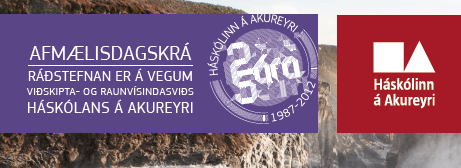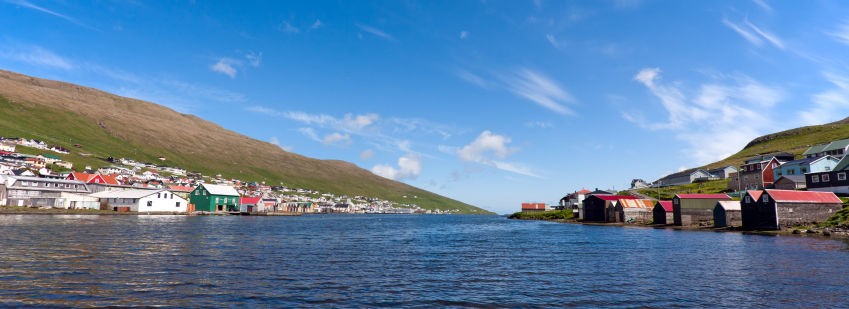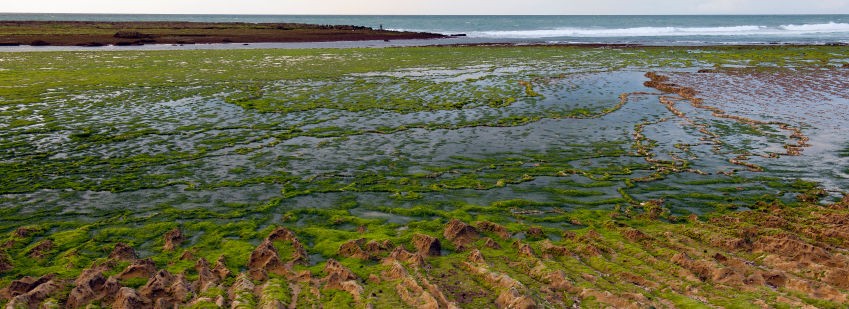A process for the effective extraction and fractionation of phlorotannins from Fucus vesiculosus with high antioxidant potentials was investigated. The antioxidant activity of F. vesiculosus extract / fractions was assessed by 2,2-diphenyl-1-picrylhydrazyl (DPPH) radical scavenging, reducing power, and ferrous ion-chelating assays. Among the crude extract and different polarity fractions, the phlorotannin-enriched ethyl acetate fraction possessed the highest DPPH scavenging activity and reducing power. This fraction was further fractionated by Sephadex LH-20 column chromatography or ultrafiltration. The antioxidant properties were evaluated by both the above chemical antioxidant tests and a mononuclear cell-based bioassay. Sephadex subfractions LH-2 and LH-3 with high total phlorotannin content exhibited strong DPPH quenching activity, comparable to those of ascorbic acid and butylated hydroxytoluene and significantly higher than that of α-tocopherol. Polyphenols in F. vesiculosus were found to consist mainly of high molecular weight phlorotannin polymers. There were no clear relationships between the degree of polymerization, molecular size, and antioxidant activity. All the subfractions separated by Sephadex LH-20 column chromatography and ultrafiltration showed a high ability to scavenge reactive oxygen species generated by mononuclear cells. Further characterization of the phlorotannin compounds was performed on six Sephadex subfractions. Several phlorotannin oligomers were tentatively identified on the basis of HPLC – ESI-MSn analyzes.
Author: admin

Fishermen's Day 2012 has begun, but the day was initially established to strengthen solidarity among fishermen, both to rejoice and to remember dead fishermen. The aim of the day is also to introduce the nation to the significance of the profession's work for the benefit of society.
Food production is one of the most important industries in Iceland. The role of the fishing industry and fish processing is the most important. The same basic principle applies in all sectors of food production, that is, the quality of the products depends on the quality of the raw material from which they are processed. Fishermen and others involved in the fishing industry know how important good fish handling is.
The first steps are especially important when ensuring the maximum quality of fish catches. This ensures that consumers get the best possible product and at the same time it is usually ensured that the value added is the greatest.
Cooling - why?
Cooling slows down the activity of pests, prolongs the time the fish is dying and thus reduces the release in the fish flesh, increases blood flow from the capillaries after bleeding and makes the flesh whiter. Last but not least, cooling reduces shrinkage.
Matís has worked with fishermen for a long time to promote the right maneuvers when handling valuables from the sea and is well acquainted with the high-quality work methods that are widely practiced in that area. Therefore, it is to no one's advantage, least of all the fishermen, when pictures of catches in unacceptable conditions are drawn, as was done in Íslandsbanki's congratulations to the fishermen in the media yesterday.
Fishermen: Let's join hands and ensure maximum value creation with good handling of catch.

For more information Sveinn Margeirsson and Jónas R. Viðarsson at Matís.
Related material: www.kaeligatt.is, The importance of good handling of fish (booklet), The importance of good handling of fish (single leaf) etc. brochures and leaflets.
Cartilage saccharides and bioactive compounds from sea cucumbers
In recent years, Matís, in collaboration with the Faculty of Pharmacy at the University of Iceland, IceProtein ehf and Reykofninn ehf, has conducted research on cartilage sugars (chondroitin sulphate) from shark cartilage and sea urchins from Icelandic smelters (Cucumaria frondosa). Studies around the world have shown a wide range of bioactivity of cartilage sugars, in vitro and in vivo, and such sugars are used as a dietary supplement, usually with glucosamine to treat osteoarthritis. Studies have also shown that cutting cartilage sugars into smaller units (oligosaccharides) can potentially increase their bioactivity in vitro. The research of Matís and partners, which was supported by the AVS Fisheries Research Fund and the Technology Development Fund, showed that cartilage sugars can be produced from shark cartilage and coarsely refined cartilage sugars from simple edema. It is also possible to produce oligosaccharides from shark cartilage with specific biocatalysts, which were prepared in the research project. The cartilage sugars show considerable bioactivity in vitro and cartilage sugars from Icelandic sea otters are particularly interesting as they show antioxidant activity, immune-regulating activity and hypoglycemic activity. The molecular structure of cartilage sugar from sea urchins is complex compared to shark cartilage sugars as they contain side chains composed of different types of sugars. The production of refined cartilage sugars from sea edema is therefore a complex process and it is anticipated that such sugars will be expensive on the market. Matís and IceProtein in collaboration with Reykofninn are now preparing further production of coarsely refined cartilage sugars from seaweed in sales and promotional activities.
In recent years, Matís ohf, The Faculty of Pharmaceutical Sciences, University of Iceland, IceProtein and Reykofninn ehf have collaborated in a research project on cartilage saccharides (chondroitin sulfate) isolated from shark and sea cucumbers from waters around Iceland (Cucumaria frondosa). The project results indicate that processing of the chondroitin sulfate from shark cartilage is a simple procedure and production of disaccharides with recombinant biocatalyst, evolved in the project, may be profitable. The chondroitin sulfate shows considerable bioactivity. Fractions of chondroitin sulfate purified from sea cucumbers, are especially interesting as they display immunomodulating activity and anti ‐ diabetic properties. However, the structure of the sea cucumber chondroitin sulfate is complex as they contain side chains composed of fucoside residues. Hence, the production and purification of chondroitin sulfate from Icelandic sea cucumbers will be a complicated procedure. Nevertheless, the results indicate that production of crude chondroitin sulfate from sea cucumber can be viable procedure.
Report closed until 01.07.2015
View report
Culturing and utilization of marine algae from the sea surrounding Iceland
The variability of floating algae is high, but in the sea in the northern hemisphere, diatoms and whip algae are most common. Floating algae have been cultivated in Japan since about 1960 and used to enrich the nutritional content of various foods and thus have a positive effect on the health of both humans and animals. The high levels of omega 3 (ω3) and ω6 fatty acids in cold seaweed also make them an interesting crop. The main goal of the project was to isolate algae from the sea off Iceland and grow them in a laboratory under different conditions. The breeding of 4 species of cold-water algae, Phaeodactylum tricornutum, Microcysitis sp., Chlorella sp. Has been successfully isolated and maintained. and Dunaliella salina. The fat content and percentage of ω3 fatty acids were highest in P. tricornutum, but the species all contained a relatively high percentage of ω3 fatty acids and were easy to grow, although their growth varied depending on the situation. The results indicate that the fat content and ratio of different fatty acids vary according to growth stages. The results also show that equidae eat Microcystis sp. and Chlorella sp. and therefore it may be interesting to use these species for the enrichment of aquatic animals used as live feed animals in aquaculture of sea larvae in aquaculture. The project has resulted in new projects where work continues on the types of algae that have been successfully grown in pure cultivation. The aim of these studies is, on the one hand, to further develop methods of cultivation with the aim of increasing the proportion of fat and processing fats from algae, and, on the other hand, experiments with the cultivation of the species in wastewater from fish farms. An experiment has also been started in the breeding of cod juveniles with the use of these species of algae in the enrichment of feed animals of larvae.
Phytoplankton is the autotrophic component of the plankton community. Phytoplankton has been cultured since 1960 in Japan for a variety of purposes, including foodstock for other aquacultured organisms and a nutritional supplement. The most abundant groups of microalgae around Iceland are the diatoms and dinoflagelleates. High omega 3 (ω 3) and ω6 fatty acid content in cold water marine algae make them interesting for culturing. The main goal of the project was to search expedient plankton suitable for culturing and investigate the effects of different culture conditions. Four species of cold ‐ water algae have been isolated in monocultures, Phaeodactylum tricornutum, Microcysitis sp., Chlorella sp. and Dunaliella salina. P. tricornutum was found to contain the highest fatty acid and content3 content but all species were relatively high in ω3 content and were easy to culture. The results indicate that the fatty acid composition differed with respect to growth stages. The results also indicate that rotifers grazed on Microcystis sp. and Chlorella sp., thereby making them interesting for enrichment of the live prey commonly used in marine aquaculture. The project has resulted in new projects with further studies on the isolated species and developing methods for increasing their fat content, processing methods for extraction of the fat content and culturing using waste water from aquaculture farms. Also, two of the algae species are presently being used for enrichment of the live prey of cod larvae in an ongoing project.
View report
Turbot - a new colonist from the sea / Sandhverfa - a new settler from the deep
The purpose of the project was threefold:
• To obtain information on the distribution, migration and population growth of a sand dune near Iceland.
• To use the reading of oxygen and carbon isotopes in grinders to assess the ambient temperature and life history of a sand dune near Iceland.
• To develop DNA genotypes and assess the genetic variability of sandeels in Iceland and compare them with sandeels in nearby oceans.
In total, samples were collected from 70 sandeels caught in Icelandic waters. The majority of the samples were collected off the southwest coast (67%) and this coincides with the ambient temperature in these areas, which is suitable for a sand dune. Sand turbines were found in the southeast and off the northeast in the autumn when the annual sea temperature in these areas is highest. About 300 samples were taken from the grinders of 25 sand turbines, aged 3 to 19 years, and oxygen (O) and hydrocarbon isotopes were analyzed by mass spectrometry. Using this method, the ambient temperature of the sampled fish was calculated to be in the range of 3-15 ° C. A clear seasonal fluctuation in ambient temperature was observed in the majority of the mills, although individual variability in ambient temperature was also significant. Lower calculated ambient temperatures were found in samples from the northeast compared to samples from the southwest and southeast coasts. The structure of a sand eel in Icelandic waters was studied with 12 genetic markers and it was compared with a sand eel from the northeast Atlantic and the Adriatic Sea. Significant genetic differences were found between all pairs of samples on the Kattegat and the Adriatic Sea, on the one hand, and between Iceland and the Irish Sea, as well as southern Norway and the Irish Sea. This basic study therefore suggests that sand eels in Icelandic waters may have originated in southern Norway. The results of the SETTLEMENTS project indicate that the sand dunes off Iceland are establishing themselves as a special Icelandic stock and that a new settler has arrived from the depths.
The aim of the LANDNEMI project was threefold:
• To collect information about distribution, migration and population growth of turbot in Icelandic waters.
• Use stable oxygen and carbon isotope signals in turbot otoliths to extract information about environmental and life history of turbot in Icelandic waters.
• To develop DNA multiplex microsatellites and determine intra- and inter-population genetic diversity of turbot.
Samples from 70 turbot caught in Icelandic fishing grounds were collected, with majority of the fish caught of the southwest coast (67%) in line with higher sea temperatures in those areas. The turbot caught in other fishing grounds around Iceland (southeast and northeast) were caught during fall when the sea temperatures reach the annual high. Nearly 300 otolith samples were extracted from otoliths of 25 turbot, with age ranging from 3 to 19 years, and subject to mass spectrometry determination of stable oxygen and carbon isotopes. The results from mass spectrometry analysis were then used to calculate temperatures experienced during the life span of the sampled turbot, and were found to be in the range from 3 to 15 ° C. Clear seasonal patterns in experienced temperature were observed in the majority of the turbot otoliths, although the individual range in experienced temperature varied substantially. A lower experienced temperature was indicated from a fish caught off Norðausturhorn compared to those caught off Suðvesturhorn and Suðausturhorn. The stock structure of turbot was investigated with 12 microsatellite markers in North-East Atlantic Ocean and the Adriatic Sea. Hierarchical analysis identified three primary genetic groups; one from the Adriatic Sea, one from Kattegat, and the third composing of samples from Iceland, south Norway, the Irish Sea and the North Sea. The third group was further divided into two clusters; Iceland and south Norway, and the Irish Sea and the North Sea. This pilot study suggests that the turbot in Icelandic waters may originate from southern Norway. Overall the results from the LANDNEMI project indicate that turbot around Iceland is emerging as an Icelandic stock unit and that the species could be considered a new colonist from the sea.
Report closed until 01.12.2013
View report
Nýting öfugkjöftu til vinnslu sjávarafurða / Opportunities in processing Megrim in Icelandic seafood industry
The aim of the project is to lay the foundations for fishing and processing of inverted jaws and to create a basis for economic activity and increased growth based on the utilization of this fish stock. The catchability and price development of inverted jaws in Iceland over months and years were studied. The utilization of the raw material for processing was also studied with the aim of fully utilizing the raw material as much as possible in order to create as much value as possible out of every kg of inverted jaw that arrives in Iceland.
The aim of the project is to analyze and develop knowledge of catching and processing Megrim sole in Iceland and create value from the use of the fish stock. The catching pattern of Megrim sole in Iceland was analyzed depending on years and months in order to recognize the catching pattern over a longer time period as well as the price development on the fishmarket in Iceland. The utilization in land processing of the fish was analyzed with the aim to develop a full utilization method in the land manufacturing process of the fish.
View report

Fred W. Allendorf, Regents Professor of Biology at the University of Montana, USA and Professorial Research Fellow at Victoria University of Wellington, New Zealand, visited Matís on 29 May.
Fred visited Matís' genetic laboratory and met with the company's geneticists and the Marine Research Institute. He has published over two hundred scientific papers on evolution, stock genetics and conservation biology and is one of the world's leading scientists in his field. Among other things, he has worked on developing methods for implementing genetic engineering for fish stock monitoring and fisheries management.

For further information, please contact Anna Kristín Daníelsdóttir, Director of Safety, Environment and Genetics at Matís.

Matís' employee, Sarah Helyar, will give a talk at the University of Akureyri on fish genetics and its significance in fisheries management.
The conference
Conservation biology: Towards sustainable management of natural resources
Location: Friday 1 June from 9:00 - 17:00 in Sólborg room M-102
Lecture by Sarah Helyar: Of Fish and SNP s: The Potential of Genetics for
Traceability In European Fisheries Management
Further information here.

Matís' three employees were on a trip to the Faroe Islands recently. There they learned about food production and research in the islands and also introduced Matís' activities to the locals.
A meeting was held with stakeholders in pelagic fishing and processing, where, among other things, Matís' research in those areas was discussed. There was a lot of interest before the meeting, where our "cousins" learned about the development of fishing and processing mackerel in this country and Matís' projects related to pelagic species. The participants in the meeting were particularly interested in the work that has been done regarding the mapping of stock units of different fish species using genetic methods, in particular herring and mackerel. There was an interest among the participants to take a greater part in this work in the future, as there are great interests at stake where it is possible to use genetic research for the analysis and monitoring of stock units and as a basis for the division of fishing rights between countries. At the same time to prevent deception in the marketing of seafood.
Matís employees also held a meeting with representatives of ministries, institutions, town representatives and research funds, where Matís' food factories were introduced. The Faroese are considering the establishment of innovation centers in the islands and were interested in learning about Matís' experience of operating the food factories, which operate in Reykjavík, Hornafjörður and Flúðir.
Matís' employees benefited greatly from this visit to the Faroe Islands and expect that it can further enhance the good co - operation that the company has with local parties.

For further information Jónas R. Viðarsson at Matís.

Matís, in collaboration with the Blue Lagoon and the Association of Icelandic Biotechnology Companies, recently held a conference on algae. A conference took place in the Blue Lagoon and it went very well everywhere.
There is great potential in the algae industry. Algae can be added to foods, making them more nutritious and tastier. At Matís, for example, kelp has been developed which has attracted a great deal of attention (http://www.matis.is/matis/frettir/nr/3331). The Blue Lagoon has used algae in Blue Lagoon cosmetics, but research has shown that algae in the Blue Lagoon reduce the aging of the skin.
Algae have also been used in food, for example, to reduce the use of salt, for example instead of MSG, but there are also known examples of algae being used in food supplements and animal feed. There are great possibilities in algae cultivation, processing and utilization in this country, as the sea area around the country is well suited, for example due to its purity.
Consumer awakening has taken place both in Iceland and elsewhere regarding the nutritional content of algae. The potential for value creation is therefore great when it comes to algae cultivation.
A Nordic project and co-operation on algae began on 1 March. The project is called "Nordic Algae Network" and the conference that was held on 15 May was connected to this. Matís organized the conference and it was sponsored by the Blue Lagoon and the Association of Icelandic Biotechnology Companies. A large number attended the conference, but the intention was to bring together people from the industry and those who conduct research on algae both in Iceland and abroad. The aim of the conference was to exchange knowledge and know-how with regard to the utilization of algae for energy consumption and valuable materials.
The agenda of the conference was as follows:
09:00 Welcome - Hordur G. Kristinsson, Matís, Reykjavík, Iceland
09:10 Nordic Algae Network - Lars Nikolaisen, Danish Technological Institute, Aarhus, Denmark
09:20 The situation in Denmark on macroalgae - Lars Nikolaisen, Danish Technological Institute, Aarhus, Denmark
09:40 Algalíf: A company takes its first steps towards establishing large-scale microalgae production in Iceland - Paul Lebeau, Algalíf, Norway
10:00 State-of-the-art on macroalgae in Ireland - Anna Soler, National University of Ireland, Galway, Ireland
10:40 Value added products from macroalgae - Sarah Hotchkiss, Cybercolloids Ltd., Carrigaline, Ireland
11:00 Icelandic macroalgae - past and present utilization - Karl Gunnarsson, Marine Research Institute, Iceland
11:20 Icelandic R&D activities on macroalgae - Hordur G. Kristinsson, Matís, Reykjavík, Iceland
11:40 Microalgae cultivation at the Blue Lagoon - Halldór Guðfinnur Svavarsson, Blue Lagoon Ltd., Grindavík, Iceland
12:00 Development of a sustainable macro- and microalgae sector in Norway, with considerations of commercialization and markets - Anne Mugaas, The Royal Society for the Welfare of Norway, Norway
"Nordic Algae Network" is funded by the Nordic Innovation Center, NICe, and more information can be found on the project's website, www.nordicinnovation.org/nordicalgae
For further information Hörður G. Kristinsson, Head of the Department of Biotechnology and Biochemistry and Director of Research at Matís.


